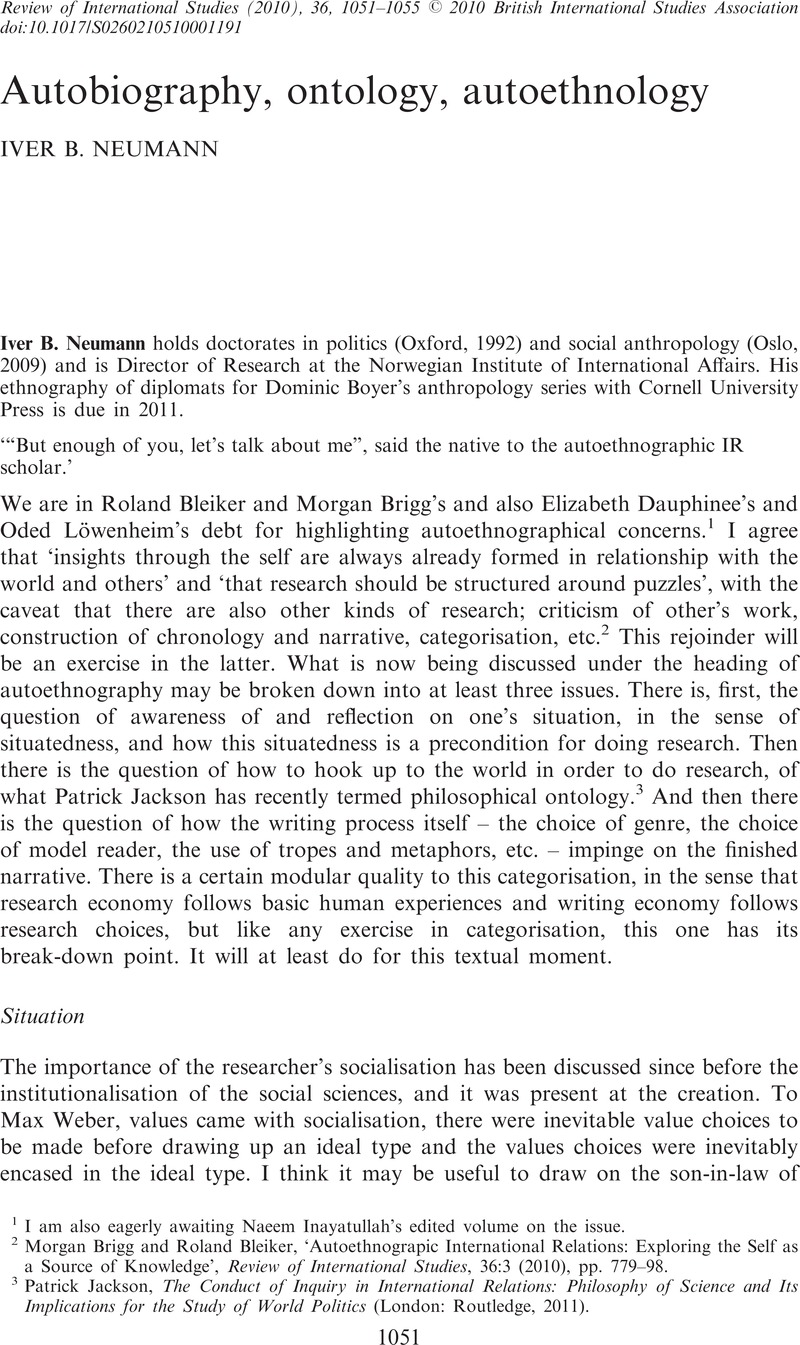Article contents
Autobiography, ontology, autoethnology
Published online by Cambridge University Press: 01 November 2010
Abstract

- Type
- Research Article
- Information
- Copyright
- Copyright © British International Studies Association 2010
References
1 I am also eagerly awaiting Naeem Inayatullah's edited volume on the issue.
2 Brigg, Morgan and Bleiker, Roland, ‘Autoethnograpic International Relations: Exploring the Self as a Source of Knowledge’, Review of International Studies, 36:3 (2010), pp. 779–798.CrossRefGoogle Scholar
3 Jackson, Patrick, The Conduct of Inquiry in International Relations: Philosophy of Science and Its Implications for the Study of World Politics (London: Routledge, 2011)Google Scholar .
4 Mauss, Marcel, ‘Les techniques du corps’, Sociologie et anthropologie, 5e edition (Paris: Quadrige/PUF [Presses Universitaires de France] (1936) 1993), pp. 363–386Google Scholar .
5 Norton, Anne, Reflections on Political Identity (Baltimore, MD: Johns Hopkins University Press, 1988)Google Scholar . Bourdieusians would probably disagree, noting that habitus is incorporated and hence also entropy-resistant. I would nonetheless stress the difference.
6 Dauphinee, Elizabeth, ‘The Ethics of Autoethnography’, Review of International Studies, 36:3 (2010), pp. 799–818CrossRefGoogle Scholar .
7 The central work of this phalanx of the discourse police is King, Gary, Keohane, Robert O. and Verba, Sidney, Designing Social Inquiry: Scientific Inference in Qualitative research (Princeton: Princeton University Press, 1994)Google Scholar .
8 The central work of this phalanx of the discourse police is Vrasti, Wanda, ‘The Strange Case of Ethnography and International Relations’, Millennium, 37:2 (2008), pp. 279–301CrossRefGoogle Scholar . For a pluralist critique of the latter, see Rancatore, Jason P., ‘It is Strange: A Reply to Vrasti’, Millennium, 39:1 (2010), pp. 65–77CrossRefGoogle Scholar . For Vrasti's response, naming her interlocutors after the old Nazi DrStrangelove, , see ‘Dr Strangelove, or How I Learned to Stop Worrying about Methodology and Love Writing’, Millennium, 39:1 (2010), pp. 79–88Google Scholar .
9 Löwenheim, Oded, ‘The “I” in IR: An Autoethnographic Account’, Review of International Relations, 36:4 (October 2010)Google Scholar . Note, however, that there is little or no soul-bearing and performing of the wound in Foucault's own text; the writing is indirect, with the personal pulse located just below the surface. Exemplary, as I see it.
10 Brigg and Bleiker, ‘Autoethnographic International Relations’, p. 785 commenting on Neumann, Iver B., ‘“A Speech that the Entire Ministry may Stand for” Or: Why Diplomats Never Produce Anything New’, International Political Sociology, 1:2 (2007), pp. 183–200CrossRefGoogle Scholar .
11 Neumann, Iver B., Diplomats and Diplomacy: An Anthropological View, Dr. Philos. in social anthropology (Oslo University, 2009)Google Scholar .
12 I am still following Jackson, The Conduct of Inquiry in International Relations.
13 Exemplars for the exercise in addition to those mentioned by Brigg and Bleiker would include Derrida, Jacques, ‘The Question of Style’, in Allison, David B., The New Nietzsche: Contemporary Styles of Interpretation, second edition (Cambridge, MA: MIT Press. ([1978] 1985), pp. 176–189Google Scholar ; and White, Hayden, Metahistory: The Historical Imagination in Nineteenth-Century Europe (Baltimore: Johns Hopkins University Press, 1973)Google Scholar . The IR John the Baptist would be Shapiro, Michael, The Politics of Representation. Writing Practices in Biography, Photography, and Political Analysis (Madison: University of Wisconsin Press, 1988)Google Scholar .
14 Löwenheim, ‘The “I” in IR’.
- 16
- Cited by




